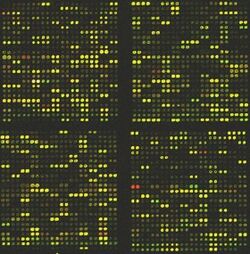Biology:RNA spike-in
An RNA spike-in is an RNA transcript of known sequence and quantity used to calibrate measurements in RNA hybridization assays, such as DNA microarray experiments, RT-qPCR, and RNA-Seq.[1]
A spike-in is designed to bind to a DNA molecule with a matching sequence, known as a control probe.[2][3][4] This process of specific binding is called hybridization. A known quantity of RNA spike-in is mixed with the experiment sample during preparation.[2] The degree of hybridization between the spike-ins and the control probes is used to normalize the hybridization measurements of the sample RNA.[2]
History
Nucleic acid hybridization assays have been used for decades to detect specific sequences of DNA or RNA,[5] with a DNA microarray precursor used as early as 1965.[6] In such assays, positive control oligonucleotides are necessary to provide a standard for comparison of target sequence concentration, and to check and correct for nonspecific binding; that is, incidental binding of the RNA to non-complementary DNA sequences.[7] These controls became known as "spike-ins".[1] With the advent of DNA microarray chips in the 1990s[8] and the commercialization of high-throughput methods for sequencing and RNA detection assays, manufacturers of hybridization assay "kits" started to provide pre-developed spike-ins.[1] In the case of gene expression assay microarrays or RNA sequencing (RNA-seq), RNA spike-ins are used.
Manufacturing
RNA spike-ins can be synthesized by any means of creating RNA synthetically, or by using cells to transcribe DNA to RNA in vivo (in cells).[1] RNA can be produced in vitro (cell free) using RNA polymerase and DNA with the desired sequence.[1] Large scale biotech manufacturers produce RNA synthetically via high-throughput techniques and provide solutions of RNA spike-ins at predetermined concentration.[1] Bacteria containing DNA (usually on plasmids) for transcription to spike-ins are also commercially available.[1] The purified RNA can be stored long-term in a buffered solution at low temperature.[1]
Applications
DNA microarrays
DNA microarrays are solid surfaces, usually a small chip, to which short DNA polymers of known sequence are covalently bound.[6] When a sample of unknown RNA is flowed over the array, the RNA base pairs with and binds to complementary DNA.[6] Bound transcripts can be detected, indicating the presence of RNA with the corresponding sequence.[6] DNA microarray assays are useful in studies of gene expression, because many of the mRNA transcripts present in a cell can be detected at the same time.[6] RNA spike-ins of known quantity can provide a baseline signal for comparison with the signal from transcripts of unknown quantity, such that the data can be normalized within an array and between different arrays.[2]
Sequencing
RNA sequencing (RNA-Seq) is performed by reverse transcribing RNA to complementary DNA (cDNA) and high-throughput sequencing the cDNA.[9] Such high-throughput methods can be error prone, and known controls are necessary to detect and correct for levels of error.[9] RNA spike-in controls can provide a measure of sensitivity and specificity of an RNA-Seq experiment.[9]
See also
- DNA spiking
- qPCR
References
- ↑ Jump up to: 1.0 1.1 1.2 1.3 1.4 1.5 1.6 1.7 Yang IV (2006). "[4] Use of External Controls in Microarray Experiments". DNA Microarrays, Part B: Databases and Statistics. Methods in Enzymology. 411. 50–63. doi:10.1016/S0076-6879(06)11004-6. ISBN 9780121828165.
- ↑ Jump up to: 2.0 2.1 2.2 2.3 "Normalization of low-density microarray using external spike-in controls: analysis of macrophage cell lines expression profile.". BMC Genomics 8: 17. 2007. doi:10.1186/1471-2164-8-17. PMID 17229315.
- ↑ "Microarray data quality - review of current developments.". OMICS 11 (1): 1–13. 2007. doi:10.1089/omi.2006.0001. PMID 17411392.
- ↑ "Estimation and correction of non-specific binding in a large-scale spike-in experiment.". Genome Biol 8 (6): R126. 2007. doi:10.1186/gb-2007-8-6-r126. PMID 17594493.
- ↑ Southern, Edwin M. (2001). "DNA Microarrays: History and Overview" (in en). DNA Arrays. Methods in Molecular Biology. 170. Humana Press. pp. 1–15. doi:10.1385/1-59259-234-1:1. ISBN 9780896038226. https://archive.org/details/dnaarraysmethods00ramp_0/page/1.
- ↑ Jump up to: 6.0 6.1 6.2 6.3 6.4 Gillespie, D.; Spiegelman, S. (July 1965). "A quantitative assay for DNA-RNA hybrids with DNA immobilized on a membrane". Journal of Molecular Biology 12 (3): 829–842. doi:10.1016/s0022-2836(65)80331-x. ISSN 0022-2836. PMID 4955314.
- ↑ Yang, Ivana V. (2006-01-01). "[4] Use of External Controls in Microarray Experiments". DNA Microarrays, Part B: Databases and Statistics. Methods in Enzymology. 411. Academic Press. pp. 50–63. doi:10.1016/S0076-6879(06)11004-6. ISBN 9780121828165.
- ↑ Schena, Mark; Shalon, Dari; Davis, Ronald W.; Brown, Patrick O. (1995-10-20). "Quantitative Monitoring of Gene Expression Patterns with a Complementary DNA Microarray" (in en). Science 270 (5235): 467–470. doi:10.1126/science.270.5235.467. ISSN 0036-8075. PMID 7569999.
- ↑ Jump up to: 9.0 9.1 9.2 Jiang, Lichun; Schlesinger, Felix; Davis, Carrie A.; Zhang, Yu; Li, Renhua; Salit, Marc; Gingeras, Thomas R.; Oliver, Brian (2011-09-01). "Synthetic spike-in standards for RNA-seq experiments" (in en). Genome Research 21 (9): 1543–1551. doi:10.1101/gr.121095.111. ISSN 1088-9051. PMID 21816910.
 |



